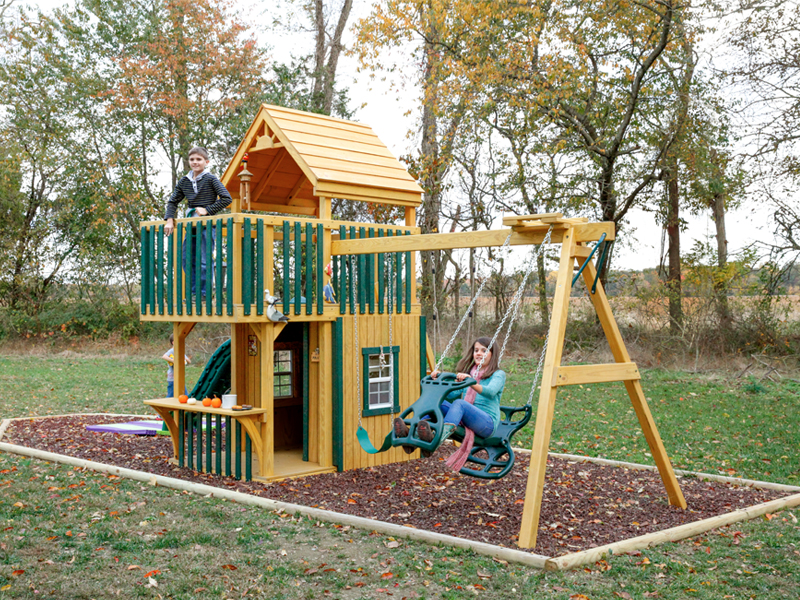
A trip to the playground wouldn’t be complete without monkey bars or climbing walls. But with all great fun comes the risk of fall. That’s why choosing the right surfacing material to go under your swing set is so important. Today we’re going to cover everything you need to know about rubber mulch. Where does it come from? Is rubber mulch safe? And so much more!
The Basics of Rubber Mulch
To make sure playtime doesn’t end in the ER, every swing set should have a “fall zone” around the structure to prevent injuries. Our top pick for keeping children safe is rubber mulch.
Made of 100% recycled tires, rubber mulch is extremely durable. In the first step of the creation process, strong magnets detect and remove any metal in the tires. Then they are shredded into small pieces called tire crumbs, which are then painted. This results in mulch that is 99.9% steel-free.
Benefits of Rubber Mulch
- Eco-Friendly — Every year, 250 million tires reach the end of their life, but rubber mulch keeps this material out of landfills.
- Extremely Shock-Absorbent — Compared to alternatives like wood chips, sand, and artificial turf, rubber is the best at preventing injuries.
- Non-Abrasive — Unlike wood-based surfacing material, you don’t have to worry about scratches or splinters.
- Aesthetically-Pleasing — Rubber mulch also looks great around your play equipment. There is a wide spectrum of colors available, and it’s easy to spread.
- Low-Maintenance — Since rubber is inorganic, this material never rots or gets moldy! This means you only need to replace it every 10–20 years (and top it off as needed).
- Prevents Pests — Rubber mulch also limits pests and weeds from taking over your yard.
- Cost-Effective — Despite a larger upfront cost, it’s the most cost-effective option because it lasts for a long time.
- ADA-Approved — Rubber mulch is an accessible material, making it perfect for homes, schools, daycares, and more.
Cons of Rubber Mulch
- Inorganic — Since rubber is an artificial material, it doesn’t add any nutrients to your soil.
- Fire Hazard — It’s also known to be highly flammable, so make sure you keep it away from heat sources.
- Expensive — Rubber mulch is more expensive upfront than alternatives like sand and wood mulch.
With these basics in mind, it begs the question: is rubber mulch safe? We know it protects kids when they fall, but are there other dangers to be worried about?
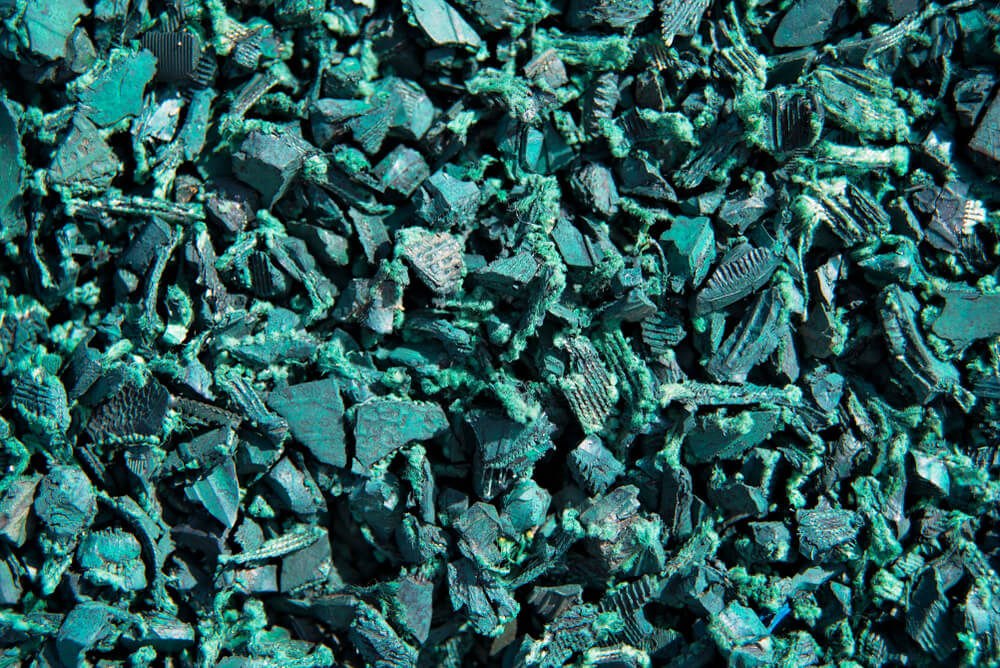
Is Rubber Mulch Safe?
It’s natural to be concerned about rubber mulch dangers and potential toxicity. However, any carcinogens that appear in tires are well below the minimum levels that could cause concern. In fact, the Environmental Protection Agency (EPA) and other federal organizations conducted a study to analyze the potential health risks of recycled tire rubber.
They found that, while chemicals such as metals and organic compounds were present, the exposure levels were low. This suggests that the health risks are limited. However, more research is needed to uncover the true impacts of rubber mulch on playgrounds.
Another concern is ingestion. Kids should avoid putting mulch in their mouths since it is a choking hazard. However, there are no worries about chemical exposure. For an extra layer of protection, we make sure to use non-toxic paint that is meant specifically for rubber. This adds a fun pop of color to your structure while protecting your loved ones from harm!
The biggest rubber mulch health concern is for people with latex allergies. If you are sensitive to rubber compounds, then avoid using this mulch around your play equipment. So is rubber mulch safe? The answer is yes! The Consumer Product Safety Commission (CPSC) recommends using this material to protect kids’ falls.
Have more questions about rubber mulch safety? Contact our team today!
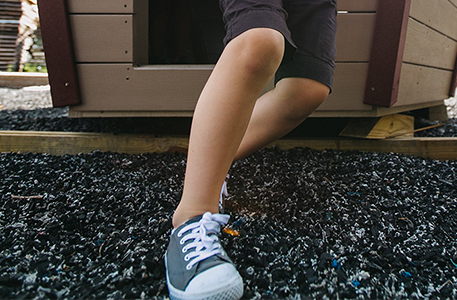
Rubber Mulch and the Weather
You’ll have your swing set year round, so it’s important to know how the surfacing material will react to various weather conditions. Thankfully, this is another way that rubber mulch shines!
Tire crumbs are significantly heavier than other options like engineered wood fiber, leaves, or sand. This helps them not get dislodged during heavy winds and rain. You can be confident knowing your mulch won’t get washed or blown away during a storm.
You also need to think about temperature. In Central Pennsylvania, our structures have to deal with intense heat in the Summer and extreme cold in the Winter. Rubber mulch does not absorb water, so it doesn’t freeze or get slippery with ice.
However, it is a strong insulator, so does rubber mulch get hot? Yes. Just like a sidewalk in direct sunlight, rubber retains heat and can get very warm. Keep this in mind if you’re running across it barefoot. To reduce this risk, pick a lighter-color mulch or place it in a shaded area of your backyard. You can also water your mulch in the Summer to lower the temperature.
How to Install Rubber Mulch
Now that you know the basics of this surfacing material and rubber mulch health concerns, you’re ready to add it to your yard! We’ll cover where to use it, how much to pour, and what it costs.
We recommend using rubber mulch around play equipment such as swing sets, playhouses, or trampolines. DO NOT use it near a heat source or in areas prone to wildfires, since the material is flammable. We also don’t recommend using it for landscaping, since rubber does not add any nutrients to your soil.
Take outdoor fun to the next level with our Amish-built play equipment.
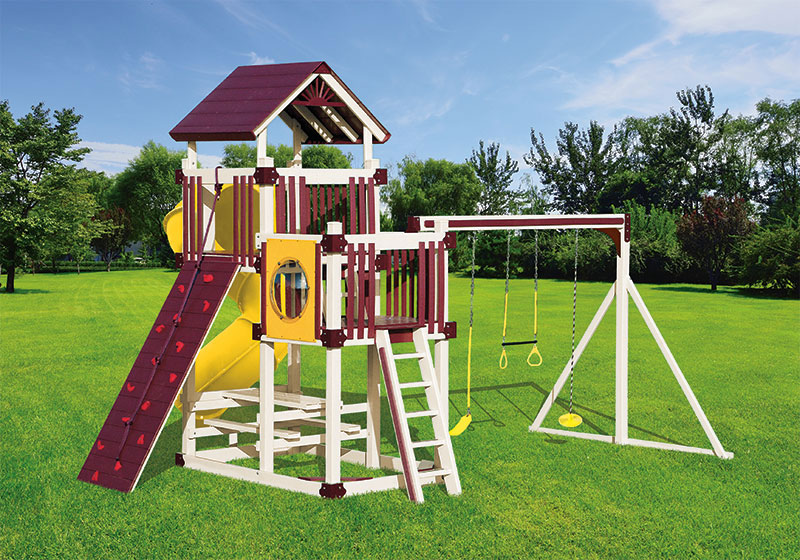
There are several guidelines to follow when determining how much material you’ll need. Instead of installing your swing set right on your grassy lot, the CPSC recommends the following process to create a safe play space and eliminate rubber mulch dangers.
- Start with the original surface (hard packed earth)
- Add 3- to 6-inch base layer of loose-fill gravel (for drainage)
- Cover with a Geotextile cloth
- Finish with a loose-fill protective layer (rubber mulch, wood mulch, sand)
- For maximum safety, your layer of rubber mulch should be 6 inches deep (If you’re using wood mulch, you would need a layer that’s 12 inches deep)
- Build out a “fall zone” with a protective base layer that expands an additional 6-8 feet in all directions around your play equipment
Our partners at Swing Kingdom have created a rubber mulch calculator to help you determine how much you need for your play area.
Before installation, our experts recommend clearing the ground completely of rocks, debris, and stumps. Also remove any old surfacing material, which can attract insects, cause mold, or even reduce the shock-absorption of your rubber mulch.
When it comes to cost, rubber mulch is more expensive than alternatives like engineered wood fiber or sand. But because of its durability, you don’t have to replace it as often, which may save you money in the long run. Rubber mulch costs about $5-$7 per square foot.
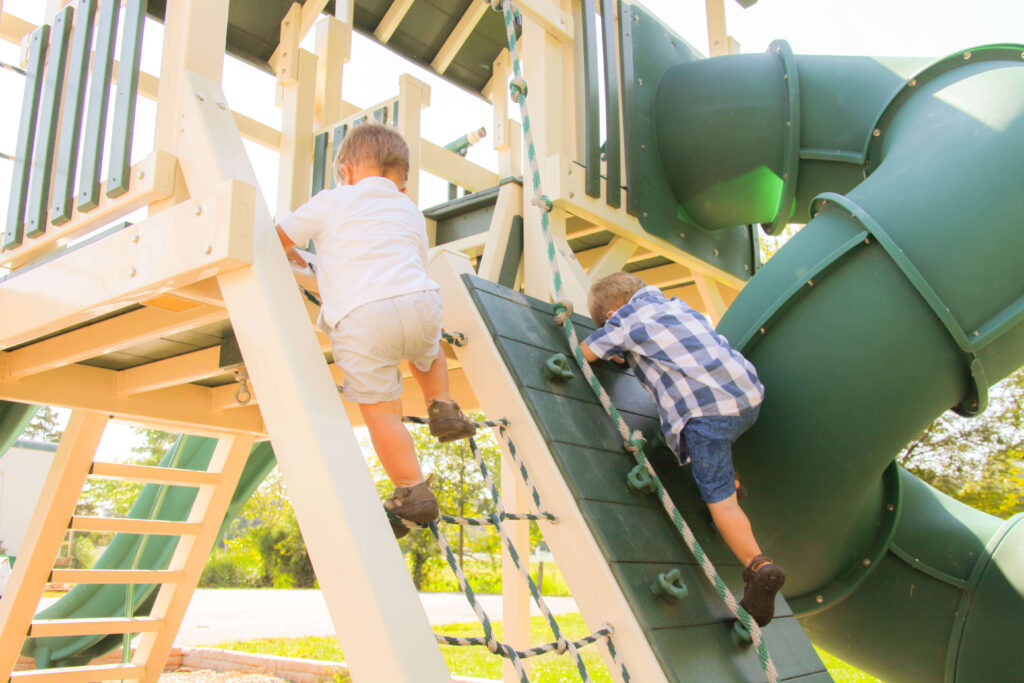
Alternatives to Rubber Mulch
Still not sure where you land on the question: is rubber mulch safe? Here are some fast facts about popular alternatives, so you can make an informed decision for your kids.
Engineered Wood Fiber (EWF)
- Loose-fill material
- Needs to be replaced every 2-3 years
- Can cause splinters
- Risk of mold
- Requires twice as much for adequate fall protection (12 inches)
- Requires annual maintenance like weeding and cleaning
- May be treated with chemicals to help prevent decay and weeds
- Not ADA accessible
- Inexpensive
- Widely available
- Simple to install
Sand
- Loose-fill material
- Needs to be replaced every 1-2 years
- Requires twice as much for adequate fall protection (12 inches)
- Needs to be cleaned and raked regularly
- Not ADA accessible
- Easily affected by wind
- Inexpensive
- Widely available
- Easy to install
Artificial Turf
- Expensive
- Aesthetically pleasing
- Natural appearance and texture
- Stays cool in the heat
- Lots of color options available
- ADA compliant
- Low-maintenance
Pour-In-Place Rubber
- Most expensive option
- One-time purchase
- Low-maintenance
- Can be embedded with designs
- ADA compliant
- Variety of colors and shapes available
- Durable
- Highly shock-absorbent
No matter what surfacing material you choose, it should be certified by the International Play Equipment Manufacturers Association (IPEMA).
For a playset that’s fun and safe, turn to Penn Dutch Structures.
Check out our Amish-built swing sets and rubber mulch options that children are sure to love.
